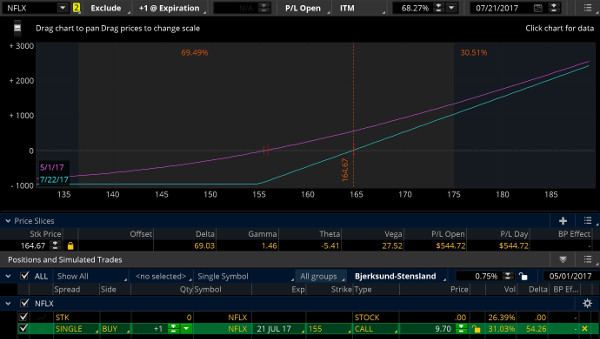Before entering an options trade, be aware of the extrinsic value and the break-even point, says Juan I. Sarmiento, DVM, Ph.D., President and Founder of PutCallGenie. He uses NFLX as an example.
For many months, even years now, the major indices have been repeatedly reaching new highs.
The inevitable question arises: How much longer is this bull market going to continue? The old cliché, “Buy low, sell high” does not seem to apply any longer.
Rather, an ominous and potentially disastrous impulse to buy high and sell higher has overtaken investors. No one really knows where the market top is, so predicting a market reversal by selling stocks seems temerarious (recklessly bold) and could result in frustration, if not large losses.
Yet every earnings season, the capacity for the market to renew its upward momentum is tested. And it appears to defy gravity with reports that beat expectations in some stocks by 10%, 20% or even more, which appear to justify the market rally.
Stocks like Amazon, Apple, Google, Netflix and less known names keep jumping to new highs with strong moves that seem to continue in the earnings season. It is precisely these outperforming momentum stocks that attract the most attention of those impulse buyers. Stepping aside to wait for declines of at least 10% seems like a waiting game that never materializes.
Let me give you an example. NFLX recently reported earnings that exceeded expectations and the stock rallied after an initial decline of 6%. This is not a recommendation, but an illustration.
What if instead of buying the stock, one would consider buying call options? The most significant features of options are leverage and risk management. So instead of committing $15,550 to buy 100 shares of NFLX (selling for $155.50/share at the time of writing), one may consider buying a call option and spend only 10% of that capital with potentially the same profitability.
If the stock goes down precipitously, we would know before it happens how much we are risking, yet we have the potential to win as much as the investor that is putting $15,550 of their capital at risk.
The technology exists today in the hands of the retail trader to better understand what option suits our needs.
How long do you think it will take for the stock to rally significantly enough to make a significant profit? Two weeks, two months, a year? Obviously, that is a hard question to answer, too.
Suppose that you decide to buy a call with a strike price that closely matches the current stock price (known as an at the money option), and that expires in a little less than 3 months from now. That would be a call option with a strike price of $155, expiring on July 21, 2017. The cost of the call option would be $9.70/share plus commissions. (There are 100 shares in a call option contract for a total cost of $970.)
The price of the option depends on several factors, the most significant of which are the time value and the implied volatility of the option. These determine the extrinsic value of the option. In this case we pay an intrinsic value of $0.50, which is the difference between the strike price ($155.00) and the market price of the stock ($155.50). There is an additional $7.95 cost (extrinsic value) due primarily to time value and implied volatility.
This means that if we were to hold this option until expiration, NFLX would have to go up more than $8.98 in stock price for us to make a profit because the extrinsic value will evaporate. The intrinsic value will increase as the stock price increases and exceeds the break-even point at expiration, which is $160.15. Fortunately, we could sell our call long before that for a profit if the stock moves up strongly and early. But that is little consolation, because statistically our probability of profit is low.
Technology, again, is in the hands of the retail trader because trading platforms can calculate for us the probability of the stock ending above the break-even point at expiration. In the example in question, the probability is only 30.50%. Before entering an options trade, one must be aware of the extrinsic value and the break-even point (see chart).
I have no doubt that the approach of buying call options may work in some circumstances. I was using it as my exclusive form of trading in the late 1990s using Elliott Wave theory (Fibonacci retracements and extensions) to time the markets. However, these days high confidence set ups to enter long calls and profit routinely are rare, and do not justify the low probability of profit.
Buying calls may be an adequate way to trade momentum stocks and thus manage risk and increase our leverage, compared to the purchase of expensive stocks. However, our probability of profit is small. There are high-confidence technical analysis approaches to predict strong directional moves, but that requires much experience from the trader.
Fortunately, there are many ways by which we can reduce the strike price, increase our probability of profit, limit our risk and ultimately profit in this prodigious bull market as well as a painful bear market. This will be the subject of following articles in this series.












